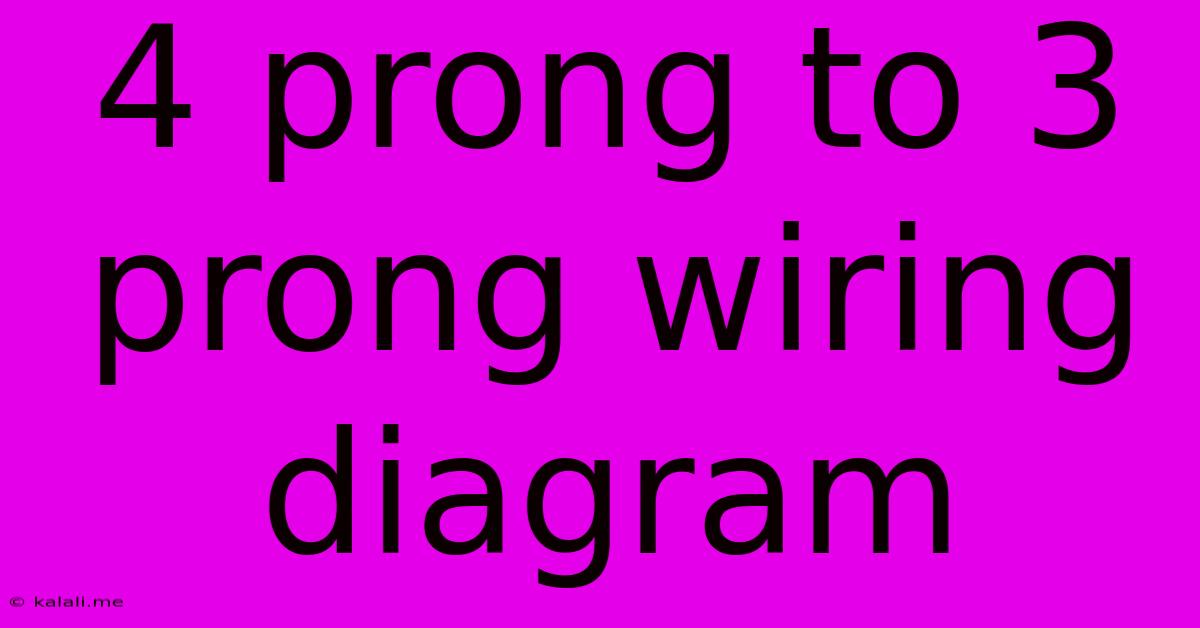4 Prong To 3 Prong Wiring Diagram
Kalali
May 29, 2025 · 4 min read

Table of Contents
Converting a 4-Prong Dryer Plug to a 3-Prong: A Comprehensive Guide
Meta Description: Learn how to safely convert a 4-prong dryer plug to a 3-prong, understanding the implications and necessary steps. This guide provides a clear wiring diagram and crucial safety precautions.
Replacing a dryer or simply updating your laundry setup might lead you to face a common electrical dilemma: converting a 4-prong dryer plug to a 3-prong. While seemingly straightforward, this process requires careful attention to safety and a clear understanding of electrical wiring. This guide will walk you through the process step-by-step, providing a clear wiring diagram and emphasizing crucial safety precautions. Improper wiring can lead to electrical shock or fire hazards, so proceed with caution and consult a qualified electrician if you are unsure.
Understanding the Difference: 4-Prong vs 3-Prong
Before diving into the wiring, let's understand the difference. A 4-prong dryer plug utilizes a 240-volt circuit and includes a ground wire for safety, crucial for preventing electrical shocks. The fourth prong is the ground, which provides a path for stray current to safely flow back to the ground, preventing dangerous buildup. A 3-prong plug typically also operates on 240 volts but may lack a dedicated ground wire. Older homes might have 3-prong outlets that aren't grounded, or the circuit may be grounded, but the outlet is not properly wired.
Important Note: Converting a 4-prong plug to a 3-prong is only recommended if your dryer's electrical requirements are compatible with a 3-prong outlet AND if the 3-prong outlet is properly grounded. If you're unsure, contact a qualified electrician immediately. This conversion removes the dedicated ground wire, so using a grounded 3-prong outlet is paramount.
What You'll Need
- Appropriate 3-prong dryer plug: Ensure it's rated for the dryer's amperage and voltage.
- Wire strippers/cutters: To safely remove the insulation from the wires.
- Screwdrivers: For removing the old plug and attaching the new one.
- Electrical tape: To securely insulate the connections.
- Wire nuts (optional): While not strictly required for some plugs, they can make connections more secure and neater.
- Voltage tester: To verify the power is off before working on the wiring.
Wiring Diagram and Steps
CAUTION: Always turn off the power to the dryer's circuit breaker before starting any wiring work. Verify the power is off with a voltage tester before proceeding.
This diagram assumes your 4-prong plug has the following wire colors (colors can vary, so check your wiring):
- Black (Hot 1): Carries 120 volts of electricity.
- Red (Hot 2): Carries the other 120 volts of electricity, resulting in the 240-volt circuit.
- White (Neutral): Returns electricity to the panel.
- Green or Bare Copper (Ground): Safety ground.
Here's a simplified wiring diagram (This is not a substitute for a qualified electrician):
4-Prong Plug 3-Prong Plug
---------------------------------
Black (Hot 1) ------> Black (Hot 1)
Red (Hot 2) ------> Red (Hot 2)
White (Neutral) ----> White (Neutral)
Green/Bare Copper (Ground) ----> (Removed - NOT connected)
Steps:
- Disconnect the power: Turn off the breaker supplying power to the dryer.
- Remove the old plug: Carefully remove the 4-prong plug from the dryer cord.
- Prepare the wires: Strip back a small amount of insulation from the ends of the wires.
- Connect the wires to the new plug: Connect the Black and Red wires to their corresponding terminals on the 3-prong plug. Connect the White wire to the White terminal. Do not connect the ground wire.
- Secure the connections: Tighten the screws on the plug terminals firmly. Use electrical tape or wire nuts for additional security if desired.
- Test the connection: Before plugging the dryer in, visually inspect your work and double-check all connections for tightness and correct wiring.
- Reconnect the power: Turn the power back on at the circuit breaker.
- Test the dryer: Run a test cycle to ensure the dryer is functioning correctly.
Safety Precautions: Always Remember…
- Turn off the power: This is the single most important safety precaution. Never work with electrical wiring while the power is on.
- Use the appropriate tools: Using improper tools can damage wires and create fire hazards.
- Consult a professional: If you are uncomfortable working with electrical wiring, or if you're unsure about any step, consult a qualified electrician. This is crucial for safety and proper installation.
- Inspect regularly: Periodically check your dryer's electrical connections for wear and tear. Replacing an aging cord is better than risking an electrical hazard.
Converting a 4-prong plug to a 3-prong should only be undertaken after careful consideration and with a thorough understanding of electrical safety. Prioritizing safety is paramount, and seeking professional help is always the best option when in doubt.
Latest Posts
Latest Posts
-
Square And Square Toot The Same Answer
May 31, 2025
-
Pick Up On As A Sound
May 31, 2025
-
How Many Cups Of Powdered Sugar In A 2lb Bag
May 31, 2025
-
What Size Screws For 1 2 Drywall
May 31, 2025
-
How To Tell If A Dog Is Chipped
May 31, 2025
Related Post
Thank you for visiting our website which covers about 4 Prong To 3 Prong Wiring Diagram . We hope the information provided has been useful to you. Feel free to contact us if you have any questions or need further assistance. See you next time and don't miss to bookmark.